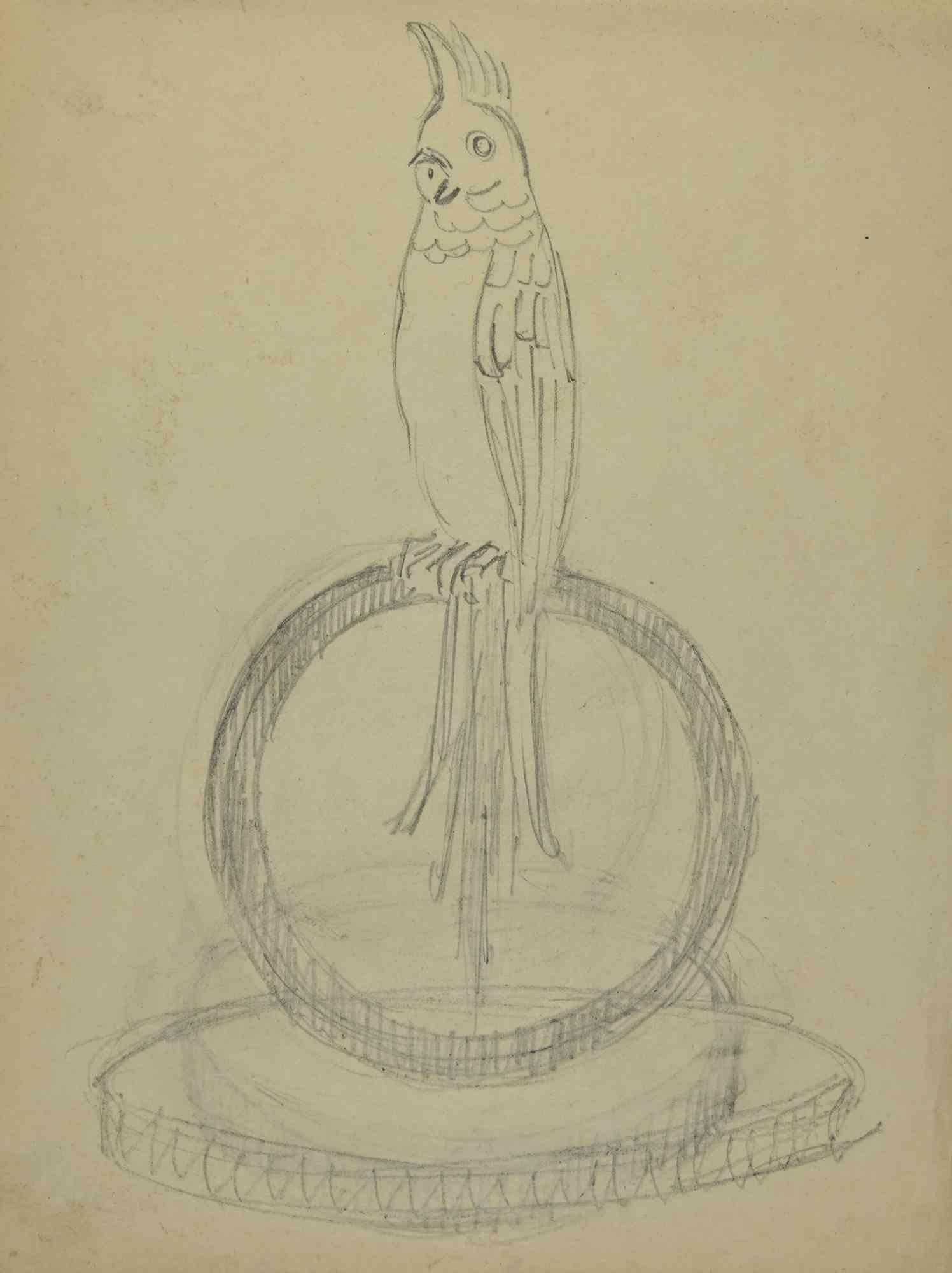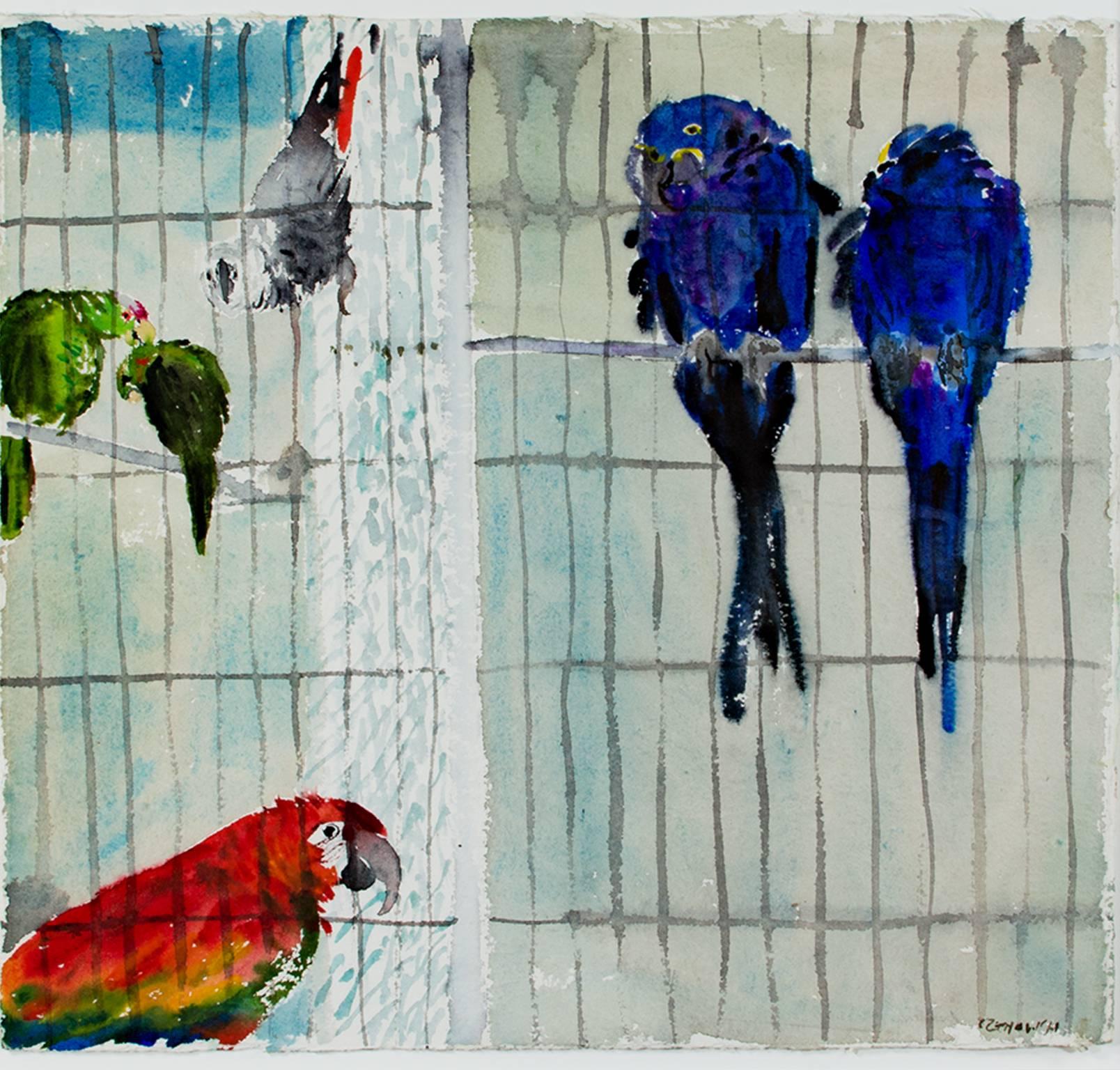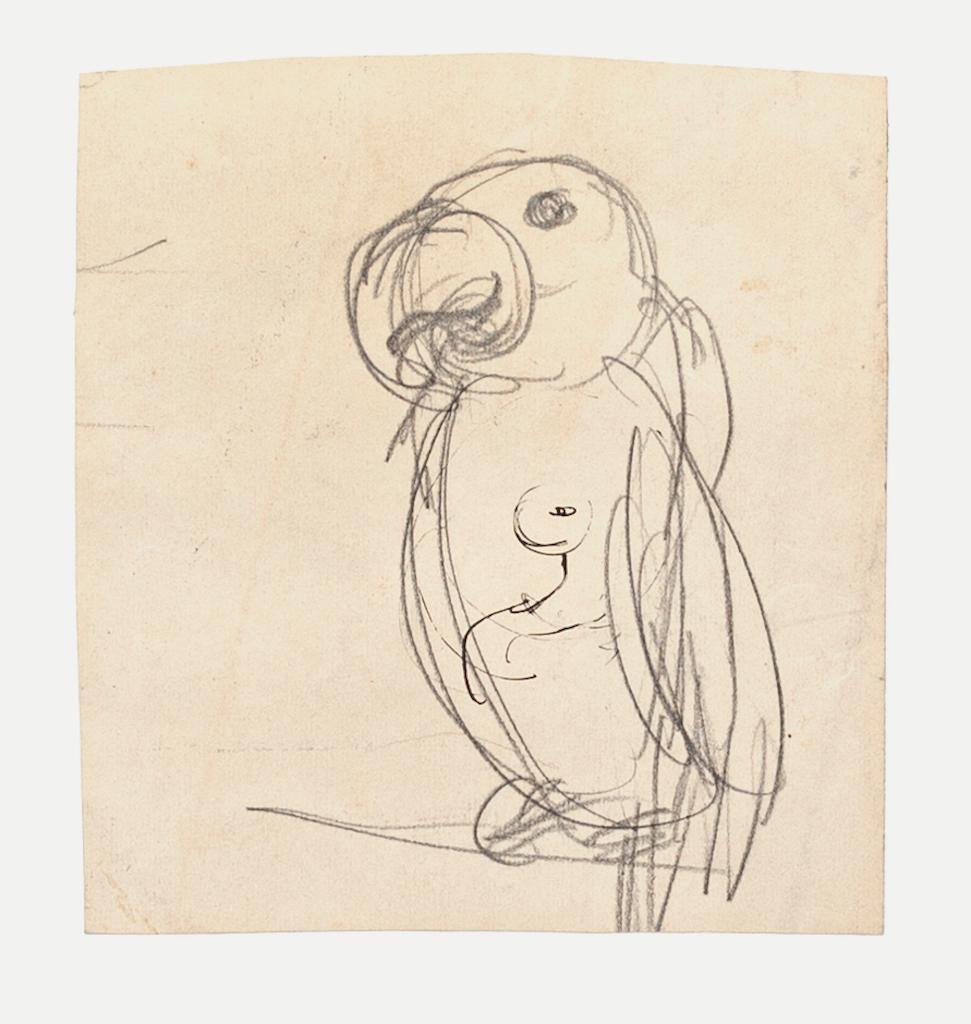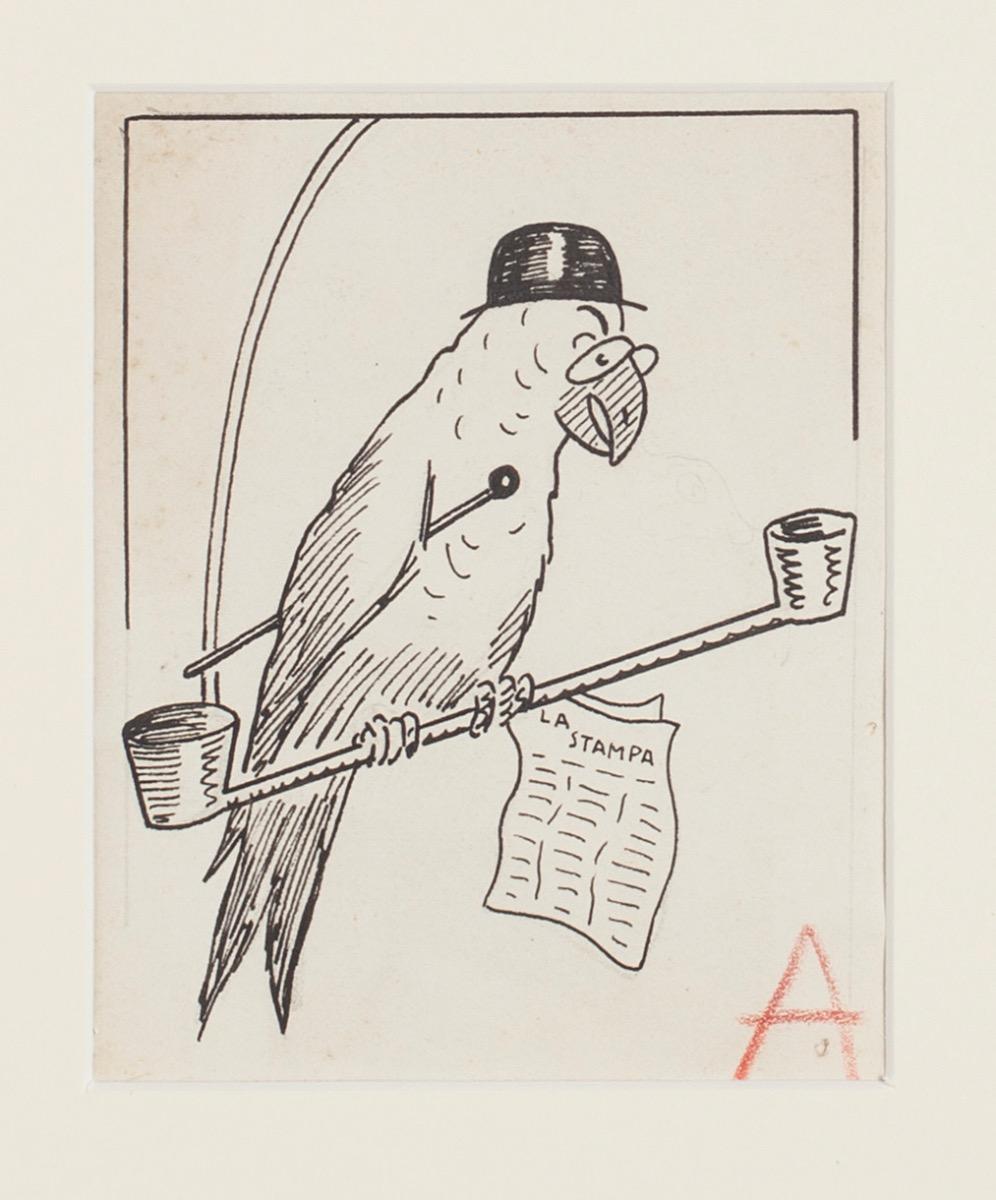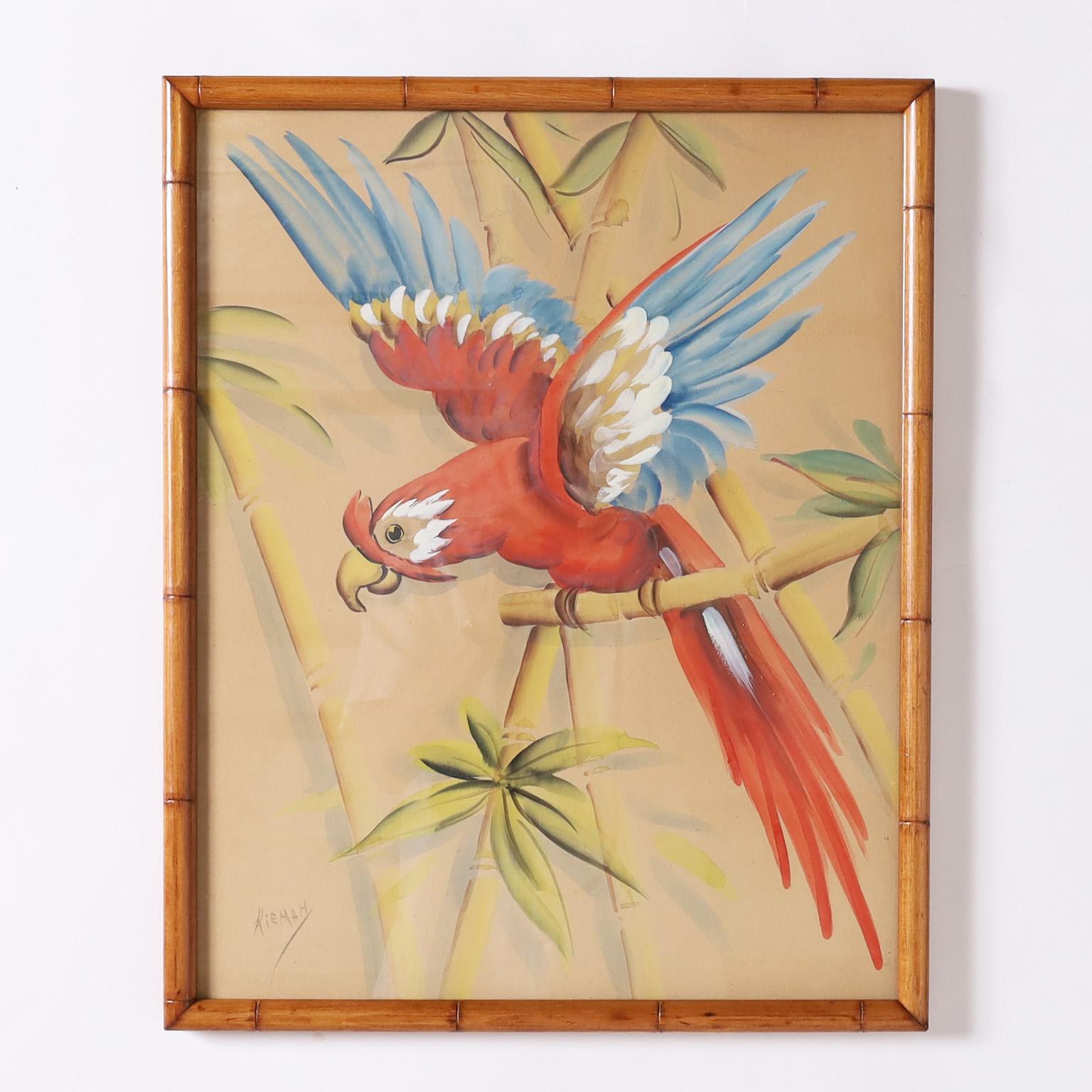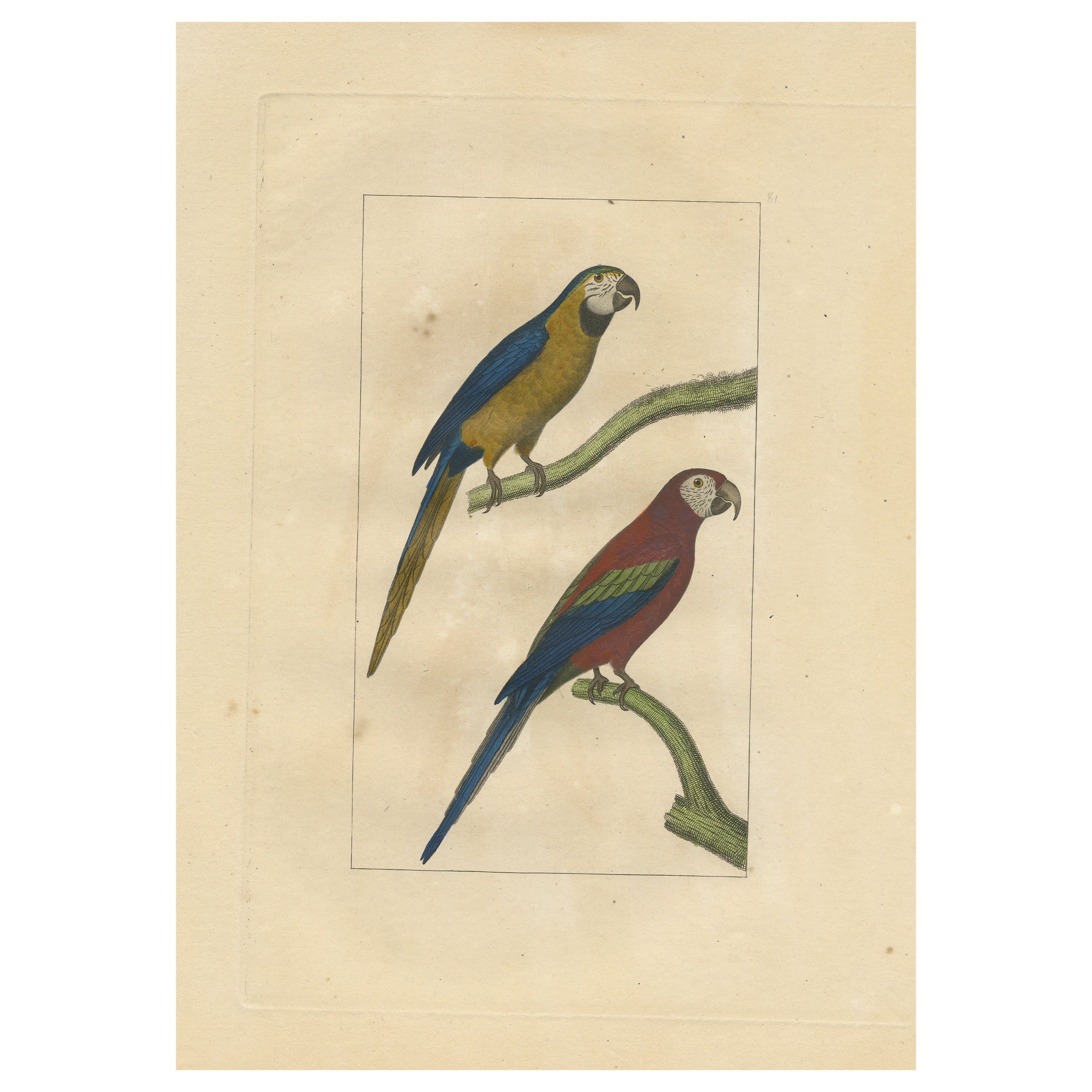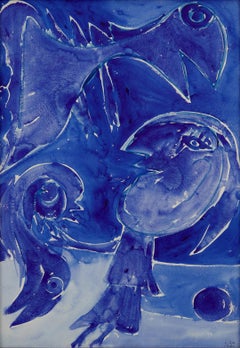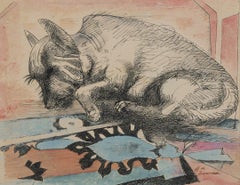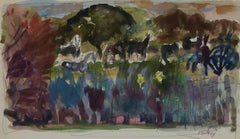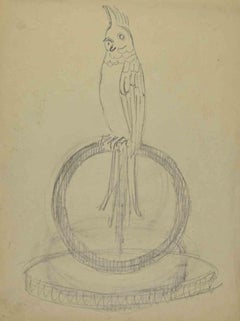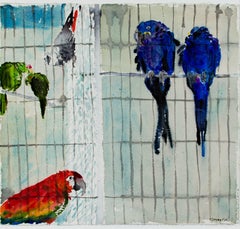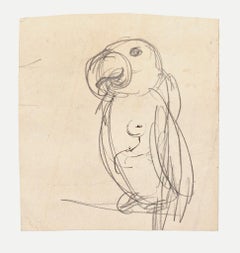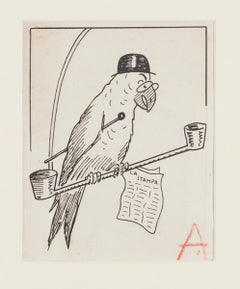Items Similar to Parrot, 20th Century Watercolor by New York Female Artist
Want more images or videos?
Request additional images or videos from the seller
1 of 9
Jane PetersonParrot, 20th Century Watercolor by New York Female Artist
$3,600
£2,748.58
€3,175.96
CA$5,053.72
A$5,632.90
CHF 2,955.39
MX$68,786.84
NOK 37,421.63
SEK 35,369.13
DKK 23,703.60
About the Item
Jane Peterson (American, 1876-1965)
Parrot
Watercolor on paper
Signed lower left
25 x 19 inches
31.25 x 25.25 inches, framed
Born in 1876 in Illinois, Jane Peterson would grow into one of the foremost women painters in New York by 1925.
Peterson’s formal art education began at the Pratt Institute where she studied from 1895 until 1901. Peterson went on to study oil and watercolor painting with Frank DuMond. She furthered her artistic studies by touring Europe and studying under Frank Brangwyn, Jacques Blanche and Andre L’Hote. While in Paris she met Gertrude and Leo Stein and became acquainted with the likes of Picasso and Matisse. Peterson returned briefly to the United States, exhibiting at the St. Botolph Club in Boston and at Knoedler Galleries in New York City in 1909.
Returning to Europe she studied in Madrid with Joaquin Sorolla. While Peterson gained vast knowledge from all of her mentors, Sorolla had incredible influence on her work. With his guidance, Peterson began to develop the brushwork, spontaneity, and brilliant palette that would come to characterize her paintings. The style Peterson developed while she was abroad spanned many different schools of painting. Her work simultaneously evokes Impressionistic and modern qualities, while maintaining a style uniquely her own. In 1910 Peterson visited Egypt and Algeria where she painted prolifically. Much of the work from this time was shown at the Art Institute in Chicago. In 1913, Peterson returned to New York and became a watercolor instructor at the Art Students League.
In the early twentieth century stylistic similarities began to emerge between Peterson and fellow American Maurice Prendergast. Both artists studied in overlapping locations throughout Europe and shared an affinity for subject matter such as vivid natural and urban scenes, heavily featuring seaside, landscapes, parks, and crowded city streets in their works. By melding traditional painting techniques with the vanguard approaches she was exposed to during her time in Europe, Jane Peterson became one of America’s most innovative artists.
- Creator:Jane Peterson (1876-1965, American)
- Dimensions:Height: 25 in (63.5 cm)Width: 19 in (48.26 cm)
- Medium:
- Period:
- Condition:
- Gallery Location:Beachwood, OH
- Reference Number:1stDibs: LU1768215264302
Jane Peterson
Jane Peterson's most innovative period was from 1910 to 1930. During this time she produced her most important work. Her trips to Venice resulted in exuberant paintings full of glowing color. This painting is from that period. The brushwork is bold and exciting. The bright round yellow carob flowers contrast with the vertical mauve carob pods. The trunks and branches of the trees form a series of triangles that reflect the lush Mediterranean landscape. Originally the painting was sold in Paris to an American collector. Jane Peterson was a leading woman post-impressionist painter of the early 20th century. Born in Elgin, Illinois, on November 28, 1876, she was interested in art throughout her childhood. In 1895, she went to New York City to study art at Pratt Institute. Before graduating in 1901, Peterson taught painting and became a popular teacher at Pratt. She then became the Drawing Supervisor of Brooklyn Public Schools. She studied oil painting with Frank Vincent DuMond who emphasized a prismatic palette. Subsequently, she studied painting with Frank Brangwyn in London, Jacques Emile Blanche and André Lhote in Paris, and Joaquín Sorolla y Bastida in Madrid. She was influenced by Impressionism and Fauvism during her studies in Paris. In 1924, Peterson's painting, Toilette, received critical acclaim at the New York Society of Painters. Her one-woman show on Fifth Avenue sold out. By this time, she had won numerous awards, was a Fellow at the National Academy of Design, and a member of many art clubs including the American Watercolor Society, Audubon Artists, Pen & Brush Club, and the National Association of Women Artists. In 1925, The New York Times characterized Peterson as "one of the foremost women painters in New York." Known for her colorful, post-impressionistic paintings of Gloucester streets and harbor on Cape Ann; palm trees along the Florida coast; street scenes in Paris, Istanbul, and New York City; and boating views in Venice. Peterson also flamboyantly executed floral subjects and dynamic genre-like portraits. Carob Tree (Ceratonia siliqua) is a small evergreen tree of the Mediterranean coasts. It has dark green, compound leaves with glossy, oval leaflets. In Italy, the carob tree blooms from September to November. Its seedpods, also known as Saint John's bread, are up to 45 centimeters long and are filled with round, hard seeds and a thick pulp. St. John's Bread was probably the husks in the Prodigal Son parable and the seed which is said to have been the original jewelers' carat weight. The Spaniards call it Algaroba, and the Arabs Kharoub, hence Carob or Caroub Pods, Beans, or Sugar-pods. It is also named Locust Pods. These pods are grown in southern Europe for feeding domestic animals as well as for human food. Carob is sold in health food stores and is often a substitute or alternate to chocolate.
About the Seller
5.0
Vetted Professional Seller
Every seller passes strict standards for authenticity and reliability
Established in 1975
1stDibs seller since 2022
34 sales on 1stDibs
Typical response time: <1 hour
- ShippingRetrieving quote...Shipping from: Beachwood, OH
- Return Policy
Authenticity Guarantee
In the unlikely event there’s an issue with an item’s authenticity, contact us within 1 year for a full refund. DetailsMoney-Back Guarantee
If your item is not as described, is damaged in transit, or does not arrive, contact us within 7 days for a full refund. Details24-Hour Cancellation
You have a 24-hour grace period in which to reconsider your purchase, with no questions asked.Vetted Professional Sellers
Our world-class sellers must adhere to strict standards for service and quality, maintaining the integrity of our listings.Price-Match Guarantee
If you find that a seller listed the same item for a lower price elsewhere, we’ll match it.Trusted Global Delivery
Our best-in-class carrier network provides specialized shipping options worldwide, including custom delivery.More From This Seller
View AllThe Blue Earth II, CoBrA movement, Mid-20th Century Danish Watercolor
By Carl-Henning Pedersen
Located in Beachwood, OH
Carl-Henning Pedersen (Denmark, 1913 - 2007)
The Blue Earth II, 1971
Watercolor on paper
Signed and dated lower right, signed, dated and titled verso
30.5 x 21.5 inches
Carl-Henning Pedersen was born in Copenhagen in 1913. At an early age he began taking part in politics, first in the youth association of social democrats and later in the youth association of communists, which better suited his revolutionary activist nature against fascism. In 1933, he attended the public high school of Humblebaek where he met the painter Else Alfelt, who he would marry in 1934 and with whom he would have two daughters. For many years the family divided its time between Copenhagen and the city of Bovbjerg, located on the North Sea, where Carl and Else had a studio. Between 1935 and 1940, Pedersen started to sketch and paint.
He exhibited for the first time, together with his wife, in “Kunstnernes Efterårsudstilling” (The Artists' Fall Exhibition) in Copenhagen in 1936. Pedersen associated with the young painters close to abstract movements, and like them, worked under difficult conditions. He went to Paris in 1939, where he encountered the work of Picasso, Matisse and Chagall.
Between 1940 and 1945, he contributed to the journal Helhesten. In the same journal, Pedersen published the text "Arte astratta o arte immaginaria," that supplied the most complete and precise definition, up to that point, of the work principles of the young generation of painters, of which he was a part. This definition, in many ways, was close to that which would be the program of the group Cobra. Between 1945 and 1960, the Danish artists went abroad and, along with Dutch and Belgian artists, founded the group Cobra, which was active between 1948 and 1951. During this period in 1948, Pedersen participated in the Biennial of Venice. He exhibited extensively with Cobra in shows such as its first important show which was held at the Stedelijk Museum of Amsterdam in 1949, “International Experimental Art.” Afterwords, Pedersen distanced himself from the group and began to travel frequently. His destinations included Greece, Italy, France, Switzerland, Norway, Lapland, Iceland, Turkey, Nepal, and Jerusalem.
He received the Eckersberg Award in 1950 from the Royal Danish Academy of Art. In 1952, he participated in “Contemporary Drawings from 12 Countries, 1945/1952,” an exhibition held at the Toledo Museum of Art in Toledo, Ohio, the exhibition also traveled to other museums in the United States, while in 1955, he took part in the group exhibition “Expressionism 1900/1955,” at the Walker Art Center in Minneapolis (also a traveling exhibition throughout the United States).
He participated in the 1952, 1955, 1958, 1961, 1964, and 1967 editions of “The Pittsburgh International Exhibition of Contemporary Painting and Sculpture” at the Museum of Art of the Carnegie Institute in Pittsburgh. The same museum also honored him with solo exhibitions in 1961 and 1968. In 1966, he exhibited at the Solomon R. Guggenheim Museum of New York in the show “European Drawings” that also traveled to Hawaii, Canada, Argentina, and Germany. In 1967, he showed at the “2. Internationale der Zeichnung” in Darmstadt, and then in 1968, he participated in the Premio Marzotto and the “Exhibition of Expressionist Art after 1950” at the Kunstmuseum of Lucerne, which then toured in Romania, Australia, Belgium, and Finland.
Pedersen received the medal of Prince Eugen in 1980, and he participated in the exhibition “Danish Artists, Carl-Henning Pedersen, Else Alfelt, Egil Jacobsen...
Category
1970s Abstract Expressionist Figurative Drawings and Watercolors
Materials
Watercolor
Tyrannus, Early 20th Century painting of a dog, Cleveland School Artist
By William Sommer
Located in Beachwood, OH
William Sommer (American, 1867-1949)
Tyrannus, c. 1935
Watercolor and pen and ink on paper
Signed lower right
7.5 x 9.5 inches
16 x 18 inches, framed
William Sommer is seen as a ke...
Category
1930s American Modern Animal Drawings and Watercolors
Materials
Ink, Watercolor, Pen
Turkeys in the Trees, Early 20th Century Farm Landscape Watercolor
By Frank Wilcox
Located in Beachwood, OH
Turkey in the Trees, c. 1922
Watercolor on paper
Signed lower right
22 x 29 inches
Frank Nelson Wilcox (October 3, 1887 – April 17, 1964) was a modernist American artist and a mast...
Category
1920s American Modern Landscape Drawings and Watercolors
Materials
Watercolor
Horses in Landscape, Late 20th Century Watercolor by Cleveland School artist
By Joseph O'Sickey
Located in Beachwood, OH
Work sold to benefit the CLEVELAND INSTITUTE OF ART
Joseph B. O’Sickey (American, 1918–2013)
Horses in Landscape
Watercolor and graphite on paper
Signed lowe...
Category
Late 20th Century Post-Impressionist Landscape Drawings and Watercolors
Materials
Graphite, Watercolor
In the Art Gallery, Early 20th Century Watercolor, Women Viewing Painting
Located in Beachwood, OH
Jules Andre Smith (American, 1880-1959)
In the Art Gallery, 1936
Watercolor and pen and ink
Signed Andre Smith, 1936 lower right
10.75 x 8.5 inches
20.25 x 17.25 inches, framed
Jule...
Category
1930s Figurative Drawings and Watercolors
Materials
Ink, Watercolor, Pen
Mayan, Large 20th Century Watercolor, Viktor Schreckengost
By Viktor Schreckengost
Located in Beachwood, OH
Viktor Schreckengost (American, 1906-2008)
Mayan
Watercolor heightened with gouache over pencil on paper
Signed lower right
39 x 29 inches
45.5 x 35.5 inches, framed
Registered with The Viktor Schreckengost foundation, stock no. 6891
The son of a commercial potter in Sebring, Ohio, Viktor Schreckengost learned the craft of sculpting in clay from his father. In the mid-1920s, he enrolled at the Cleveland School of Art (now the Cleveland Institute of Art, or CIA) to study cartoon making, but after seeing an exhibition at the Cleveland Museum of Art he changed his focus to ceramics. Upon graduation in 1929, he studied ceramics in Vienna, Austria, where he began to build a reputation, not only for his art, but also as a jazz saxophonist. A year later, at the age of 25, he became the youngest faculty member at the CIA. In 1931, Schreckengost won the first of several awards for excellence in ceramics at the Cleveland Museum of Art, and his works were shown at the Metropolitan Museum of Art, the Art Institute of Chicago, the Panama-Pacific Exposition in San Francisco, and elsewhere.
By the mid-1930s, Schreckengost had begun to pursue his interest in industrial design. For American Limoges...
Category
20th Century Art Deco Figurative Drawings and Watercolors
Materials
Gouache, Watercolor
You May Also Like
Parrot - Drawing by Joseph Alexander Colin - Mid-20th Century
Located in Roma, IT
Parrot is a drawing realized by Joseph Colin in the Mid-20th Century.
Pencil on ivory-colored paper
Good conditions with slight foxing.
The artwork is realized through deft expres...
Category
Mid-20th Century Modern Figurative Drawings and Watercolors
Materials
Pencil, Paper
Contemporary female artist parrots animal cage watercolor painting signed
By Alicia Czechowski
Located in Milwaukee, WI
"Parrots" is an original watercolor signed by Alicia Czechowski. The artist signed the piece lower right. This piece depicts six multi-colored parrots in a cage.
16 3/4" x 18" art
...
Category
1960s Impressionist Animal Drawings and Watercolors
Materials
Watercolor
Parrot - Original Pencil on Paper by G. Galantara - Late 19th Century
By Gabriele Galantara
Located in Roma, IT
Parrot is an original drawing in pencil on paper by Gabriele Galantara (1865-1937).
In good conditions except for some diffused foxings.
Sheet dimension: 12.5 x 11.5 cm.
This is a...
Category
Late 19th Century Figurative Drawings and Watercolors
Materials
Pencil
Parrot - China Ink by Bruno Angoletta - Early 20th Century
By Bruno Angoletta
Located in Roma, IT
Parrot is an original china ink drawing on paper, realized by Bruno Angoletta (1889 - 1954), an italian artist.
On the bottom right margin there is the sigla of the artist,A.
White...
Category
Early 20th Century Modern Figurative Drawings and Watercolors
Materials
Ink
Mixed Media Painting of a Parrot in a Faux Bamboo Frame
Located in Palm Beach, FL
Lofty mixed media painting on brown paper of a parrot executed in classic Art Deco style with a bold stroke using watercolor and gouache. Signed by not...
Category
Early 20th Century Art Deco Animal Drawings and Watercolors
Materials
Watercolor, Gouache
Hand Colored Antique Bird Print of Parrots
Located in Langweer, NL
Untitled bird print of parrots. Source unknown, to be determined. Published circa 1860.
Category
Antique Late 19th Century Prints
Materials
Paper
$339 Sale Price
20% Off
More Ways To Browse
Female Artists
Picasso Chicago
St Frank
Paris Street Scene Watercolor
Steiner Paris
Maurice Jacque
Vanguard Vintage
Painting Blanche American
Parrot Oil Painting
Oil Painting Of Parrots
Joaquin Sorolla
Nellie Mae Rowe
Sutter Buttes
Andrea Collesano
Bart Lindstrom
Charles Edward Burdick
Elizabeth Bourdet
George Buckett Poodle
